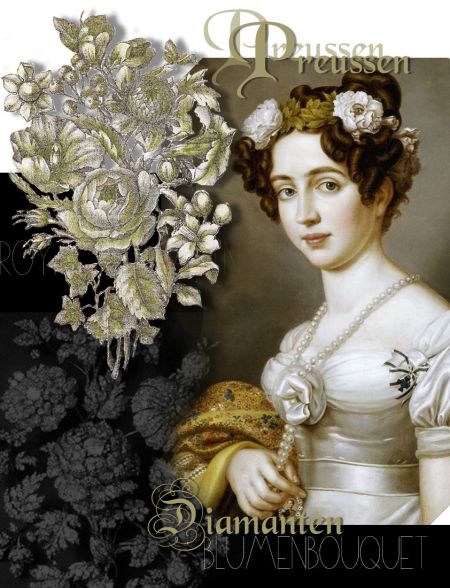
Elisabeth von Bayern| Kronprinzessin von Preussen| Königin von Preussen | Hohenzollern Schmuck

Preussen Prussia Hohenzollern history Royal Jewellery & Aristocratic Jewels antique jewellery historian diamonds tiara jewels jewel royaljewels princesssophie princesskira crownprincesscecilie prussianroyalfamily germanimperialfamily hohenzollern imperialfamily germanroyalty germanroyals royal royals royalty Kaiserin von Preussen, Königin von Deutschland, Kaiserin von Deutschland,kronprinzessin, princely majesties royalhighnesses imperialhighness royals royalty realeza royauté almanachdegotha europeanroyalty royaldynasty imperialfamily royalfamily princelyfamily royalfamilies hohenzollern prussianroyalty prussianroyalfamily germanempire germanroyalty germanroyals,prussia royal tiara,prussian royal tiaras, prussian aquamarine, Prussian Royal Aquamarine, Prussian Royal Aquamarine Tiara, Prussian Royal Aquamarine Necklace, Prussian Royal Aquamarine Earrings,

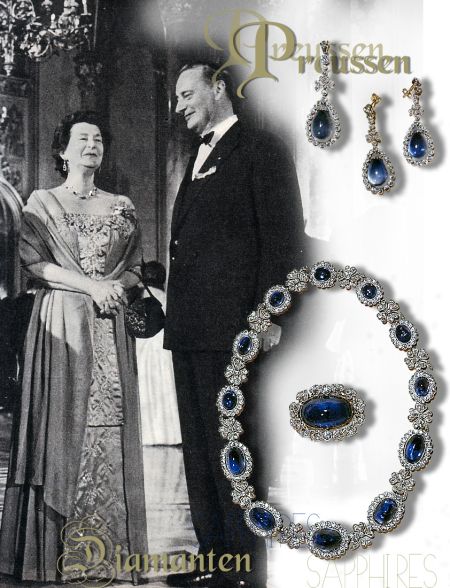
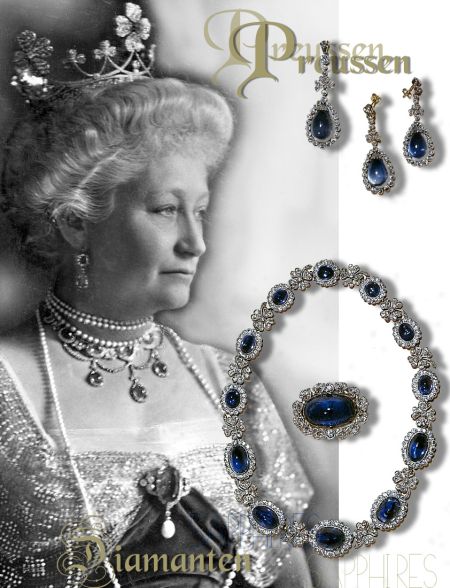
Die Brosche mittig ist aus einem Cluster, des Colliers gefertigt und hat einen großen Cabochon.
Im Gegensatz zu der Brosche die von Kaiserin getragen wird und einen facettierten großen Saphir als Zentrum hat.
Auguste Viktoria Friederike Luise Feodora Jenny of Schleswig-Holstein-Sonderburg-Augustenburg was the wife of Emperor Wilhelm II and as such from 1888 to 1918 German Empress and Queen of Prussia.
The empress often wore this large oval diamond brooch and Devante de Corsage and was shown in different pictures. The large faceted oval sapphire is framed by 20 evenly sized diamonds and two larger diamonds on the short lengths. A large, even pearl hangs movable on the brooch with an eyelet and three diamonds. There are flourishes made of diamonds on both sides.
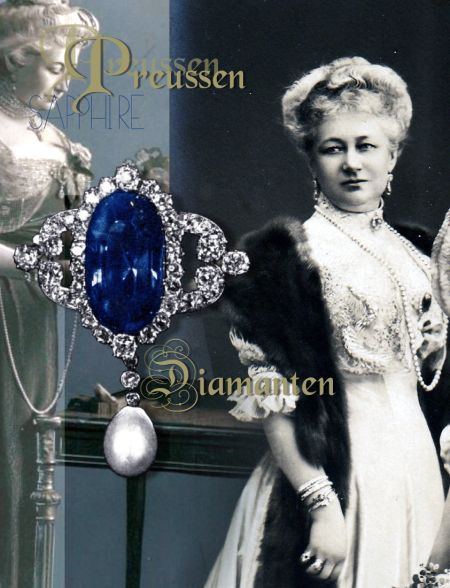
Die spannenden Geschichten hinter den historischen Schmuckstücken der Kaiserin Auguste Victoria………
,
The story behind the historic jewels of the Empress of Germany – the original jewel, a diamond stomacher and necklace once the gift from Sultan Abdul Hamid to the Empress Auguste Victoria.
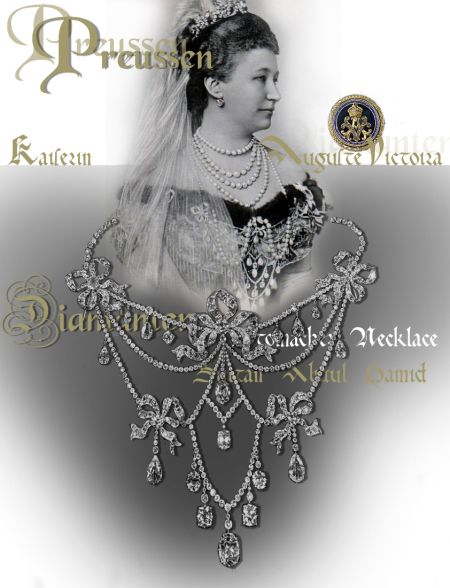
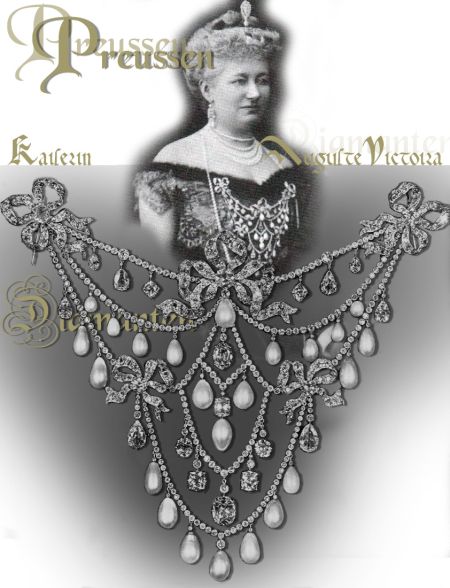
Elizabeth Angela Veronica Rose Nall-Cain, only daughter of Lord and Lady Brocket god-daughter of Queen Elizabeth the Queen Mother, wearing the heirloom diamond tiara, of the family when she married at St James, Spanish Palace the Earl of Bective, son of the Marquess of Headfort, in 1958,
Her mother Lady Brocket wore the diamond palmette tiara, also at Opening Parliament in 1936 in the style of the time on her forehead and the matching diamond fringe necklace and at the coronation in 1937.

When Antalya Stephanie Lauren Nall-Cain, daughter of the Lord Brocket, married Alexander Frederick Prince of Prussia (b.1984), son of Andreas Prince of Prussia in September 27th, 2020 at Brockethall, she wore traditionally the palmette diamond tiara of her family.

Antalya Princess of Preussen The new Princess of Preussen, chose not a wedding tiara of the „Preussen“ family. The bride wore a stunning ivory gown with cape detail, adorn with her family tiara, the Brocket Tiara. It had previously been worn on the wedding day of her grandmother and aunt, see on top. The kokoshnik base could be worn without the fountains or diamond palmettos on top, in a very sleek way.





On 2 March 1879 Queen Victoria recorded in her journal that she had told her son, Arthur, Duke of Connaught, she would give his wife to be, an Indian diadem.
Then on 12 March 1879 Queen Victoria described showing her gifts to the bride and others, again referring to an Indian diadem.
The Duchess was pictured, with the royal tiara, only one time in 1893, see above, and give it later to her daughter Princess Patricia of Connaught.
In 1911, the Duke was appointed Governor General of Canada. Princess Patricia accompanied her parents to Canada, and she became popular there, on those occasion she wore her mothers wedding gift, the Indian diamond tiara as stomacher, without the center, of a movable ornament like a sarpech on top, with hanging emerald drop.
Sarpech, also known as an aigrette is a turban ornament that was worn by significant Hindu and Muslim princes.

She had her own jewels and tiaras for royal events, because , her mother’s precarious health meant the unmarried Patricia often step in for her mother, as vice-regal hostess, especially during the Duke of Connaught’s tenure as Canada’s governor general from 1911 to 1916.
click for more history :
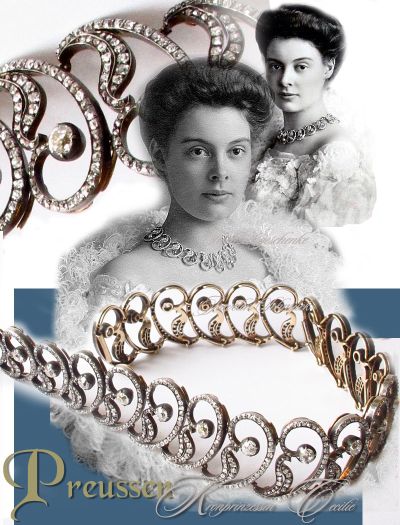
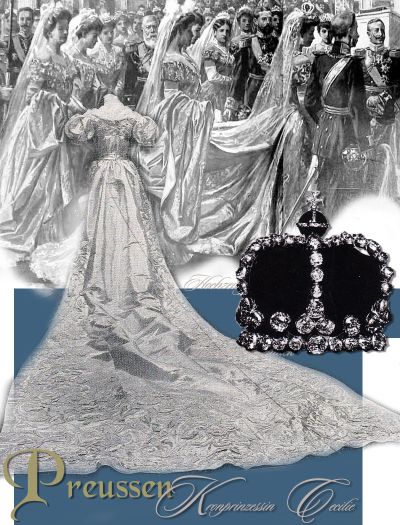
Important news after my research:
Click for more History!
Notes from the press of the days:
It is going to cost Germany over half a million dollars to get her future Emperor married, but in return for their money the folk of the fatherland will have a show of pomp and ceremony such as seldom has been seen in modern Europe. In the preparations for his eldest son’s wedding to the Duchess Cecilie of Mecklenburg-Schwerin, which is now set for Monday, May 22,1905, the Kaiser is giving full reign to his love of imperial splendor and display.
On the marriage ceremony itself, which will take place in the magnificent new cathedral in Berlin in the presence of an exalted company whose like never has gathered under one roof, $50,000 will be spent. The presents which will be given to the young couple by municipalities and public corporations will amount to a. total of at least $250,000, while a similar sum is being spent on the bride’s trousseau.
On her wedding day the Duchess Cecilie of Mecklenburg-Schwerin will be almost 19 years of age, while her young husband will have attained the age of 23.
No part of the elaborate ceremonial In connection with her wedding will be more impressive than the Duchess Cecilie’s journey from her home in Schwerin to Berlin, which will take place a few days before her marriage. From the palace of her brother, the Grand Duke of Mecklenburg-Schwerin with whom she has lived up to now, to the Schwerin railway station the Duchess will be escorted by the Grand Duke himself, by the Ministers of state of the grand duchy, by the high officers of the garrison at Schwerin and by a deputation of noblemen and noblewomen representing the leading families of Mecklenburg aristocracy.
Surrounded by a magnificent company, Duchess Cecilie will drive in an open carriage from her home to the railway station, where a special train will be waiting to convey her to Berlin. This train will consist of cars painted in blue and gold. The locomotive will be gaily decorated with flowers and a wreath of myrtle will be hung around the stack.
The Grand Duke and the Grand Duchess of Mecklenburg-Schwerin as well as a magnificent suite consisting of over fifty persons will escort Duchess Cecilie to Berlin, a journey of about three hours. A guard of honor will be drawn up on the platform of the station at Schwerin and at the moment the train begins to glide away on its journey these troops will present arms, a roll will be beaten on the drums and a blast of trumpets will proclaim the departure of the Crown Prince’s bride. At the same moment the guns of the fortress of Schwerin will boom out a salute of thirty-three guns, and there will be cheers from the children of the public schools of the little capital, drawn up on the platform.
The arrival at Berlin will be a still more impressive affair. On the platform the German Emperor, the Crown Prince, the five younger sons of the Kaiser, the Emperor’s brother, Prince Henry, and four other royal princes of the Hohenzollern family will be waiting to greet Duchess Cecilie. The moment the train slops the bride-elect will descend the steps of the saloon car and will be embraced and kissed first by the Emperor and then by the Crown Prince, who probably will secretly resent the rigid rules of court etiquette which gives this imperial father the right of precedence on this occasion.
Duchess Cecilie will then shake hands with the other royal princes while the usual military honors are being paid to her. The royal party will then enter open carriages to drive to the Imperial castle situated in the heart of the city of Berlin. The Emperor and the Duchess Cecilie will ride side by side in the first carriage, the Crown Prince sitting opposite to them with his back to the coachman. The other royal princes and the various suites will follow in other carriages, of which there will be about thirty in the procession. The state carriages conveying the Emperor, Crown Prince and Duchess Cecilie will be drawn by six white horses and will be preceded and followed by a squadron of cavalry guards as an escort. The streets through which the procession of the carriages will pass will be lined with spectators who will accord their future Empress a warm popular reception.
The German Empress will be waiting on the threshold pt the imperial castle, where she will embrace and kiss her future daughter-in-law. Duchess Cecilie will remain in her residence at the imperial castle, but the Crown Prince will continue to reside in the palace at Potsdam, coming into Berlin each morning by train and returning each evening, for etiquette provides that he shall not sleep under the same roof as his bride during the few nights preceding the wedding. The last day or two will be fully occupied with the completion of all the necessary arrangements.
The wedding ceremony will be solemnized in the new cathedral which the German Emperor has erected on the open space in front of the imperial castle in Berlin. The distance from the imperial castle to the cathedral is only two or three hundred yards and the wedding party will pass from one building to the other on foot.
The Crown Prince will wear the uniform of the First Regiment of Guards, consisting of a long blue coat, blue trousers and gaiters extending to the knees. He will wear a helmet with white plumes and his breast will be decorated with tho ribbons of all the exalted orders to which he belongs.
After the Crown Prince has taken up his stand in the cathedral in front of the altar the German Emperor will leave the imperial castle, accompanied by the Empress, the other members of the Prussian royal family and all the royal guests, who will be present as representatives of the reigning families of Europe.
These will include the King of Spain; the Czar‘ s brother. Grand Duke Michael of Russia: the successor to the Austrian throne. Archduke Francis Ferdinand, the Duke of Aosta, representing Italy, and the Prince of Wales, representing England.
Including the rulers of the smaller German states, there will be twenty reigning monarchs and thirty royal Princes and Princesses, making a total of over fifty royal personages present at the wedding. These royalties, with their suites of gorgeously uniformed officers, will form a company of unprecedented brilliancy.
After the members of this party have entered the cathedral and have taken their allotted seats the bride will leave the Imperial castle to proceed to the ceremony.
She will wear a white dress adorned with the costliest lace, for which her dressmaker will receive a check for $25,000; a long white veil and a small wreath of myrtle with the nuptial crown, „The Prinzessinnenkrone „on her head.
The ceremony will last rather more than half an hour and as soon as it is concluded the organ will strike up a wedding march, while the guns of the forts around Berlin will fire a salute of 101 guns.
A magnificent state banquet will be given In the imperial castle, at which covers will be laid for five hundred guests. The Crown Prince and the Crown Princess will sit side by side at one end of the central table, with the Emperor and the Empress opposite them at the other end. The Emperor will propose the toast of the young couple, and he’s expected to make a speech in which he will refer to the high destiny in store for his son when he is called upon to ascend the Imperial throne of Germany.
The wedding presents, which will number many hundreds, will be piled in heaps on tables in one of the big halls of the castle and will be inspected by the guests of the wedding party.
Later In the day the Crown Prince and his bride will leave Berlin to spend their honeymoon at the Crown Prince’s estate in Silesia.
The distinguished pair will possess a stable of 200 horses, some for riding and some for driving.
The bride’s trousseau will come of hundreds of trunks, full of coats and fur tunes articles. It is hat the presents given to the imperial couple by royal personages throughout Europe win amount to a total of at least S28M*